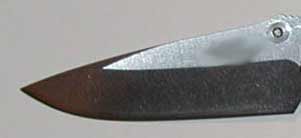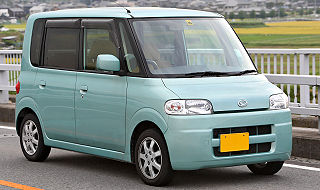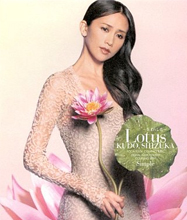Tanto may refer to:
Tanto may refer to:
A point is a small dot or the sharp tip of something. Point or points may refer to:

Daihatsu Motor Co., Ltd., commonly known as Daihatsu, is a Japanese automobile manufacturer and one of the oldest surviving Japanese internal combustion engine manufacturers. The company's headquarters are located in Ikeda, Osaka Prefecture.

A tantō is a traditionally made Japanese knife that were worn by the samurai class of feudal Japan. The tantō dates to the Heian period, when it was mainly used as a weapon but evolved in design over the years to become more ornate. Tantō were used in traditional martial arts. The term has seen a resurgence in the West since the 1980s as referring to a point style of modern tactical knives, designed for piercing or stabbing, though the style isn't present on any traditional tantō.

A blade is the sharp, cutting portion of a tool, weapon, or machine, specifically designed to puncture, chop, slice, or scrape surfaces or materials. Blades are typically made from materials that are harder than those they are intended to cut. This includes early examples made from flaked stones like flint or obsidian, evolving through the ages into metal forms like copper, bronze, and iron, and culminating in modern versions made from steel or ceramics. Serving as one of humanity's oldest tools, blades continue to have wide-ranging applications, including in combat, cooking, and various other everyday and specialized tasks.
Zebra is one of several species of the horse genus Equus whose members have distinctive stripes.

Drop point is a style of knife blade that slopes on the spine of the blade from the handle of the knife to the tip of the blade. This allows the spine of the blade to continue forward to the tip of the blade. This way the point is also aligned with the center axis of the knife, eliminating any pitch momentum when stabbing.
Cuore, pronounced[ˈkwɔːre], the Italian-language word for "heart", may refer to:
Applause is an expression of approval by the act of clapping.

The Daihatsu Tanto is a kei car manufactured by the Japanese carmaker Daihatsu. It was introduced at the 2003 Tokyo Motor Show as a vehicle based on the Move's "tall" body style, and followed by the Tanto Custom in July 2005.

Shodokan Aikido is the style of Aikido founded by Kenji Tomiki. Shodokan Aikido is sometimes referred to as 合気道競技 meaning "Competitive Aikido" or "Sport Aikido" because of its use of regular competitions.
A tantō is a type of knife in Japanese martial arts.

The Daihatsu Tanto Exe is a kei car manufactured by the Japanese carmaker Daihatsu. The Tanto Exe made its debut at the 2009 Tokyo Motor Show and was launched on 24 December 2009. It was also sold by Subaru as the Subaru Lucra, which was launched on 20 April 2010.
Move or The Move may refer to:
Storia or La storia may refer to:
Joy is an emotion in response to a pleasant observation or a remembrance thereof.

The Daihatsu Thor is a mini MPV with sliding doors designed and manufactured by Daihatsu, and sold by Daihatsu, Toyota and Subaru. It is a five-seat MPV based on the M700 series Boon and was introduced on 9 November 2016 as the successor to the Coo. It sits below the Sienta in Toyota's minivan line-up.

"Lotus (Umareshi Hana)" (Lotus ~生(う)まれし花(はな)~, lit. "Lotus (Flower in Bloom)") is a song recorded by Japanese singer Shizuka Kudo, from her sixteenth studio album, Tsukikage. It was released by Pony Canyon as the album's lead single on February 16, 2005, and is Kudo's first single in close to three years. The song was featured on TV commercials for Daihatsu Tanto, starring Kudo herself, which had previously featured Kudo singing a cover of Seiko Matsuda's "Sweet Memories".

The Daihatsu Move Canbus is a retro-styled semi-tall kei car with rear sliding doors manufactured by the Japanese carmaker Daihatsu since 2016. Despite adopting the "Move" nameplate, the car shared its underpinnings with the Tanto instead.
The Daihatsu New Global Architecture (abbreviated as DNGA) is a modular unibody automobile platform that underpin various Daihatsu vehicles and its rebadged versions supplied for Toyota, Subaru, and Perodua. Introduced in 2019, it is aimed for vehicles built for the Japanese market and overseas emerging markets. Daihatsu has planned to introduce the platform to 21 models and 15 body types with a targeted annual production of 2.5 million vehicles to be sold in 90 countries by 2025. Despite the similar naming, it is not mechanically related to the Toyota New Global Architecture.
XMZ may refer to: